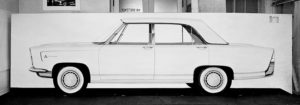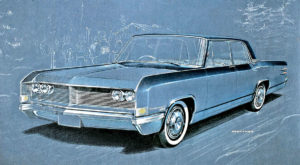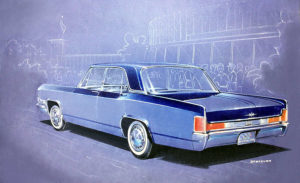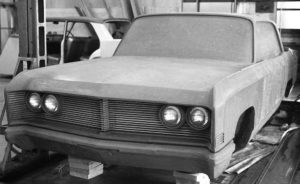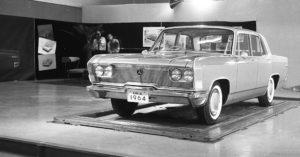American car design development learned from Hans Bretzner
Kiyoshi Honda
―― Change of direction at beginning
Mitsubishi entered the passenger car market in 1960 with the Mitsubishi 500, followed by the Colt 600, the Minica and the Colt 1000. At that time, there were two opinions in the company that a luxury car should be developed as soon as possible and the opinion that a luxury car was premature considering the company’s technical and sales capabilities. In the midst of this situation, Mitsubishi Corporation (a trading firm) approached the company with a proposal to license the production of the Italian Fiat 2100 through a technical tie-up, and the company began to move in this direction. In 1961, after confirming the performance of the vehicle through driving tests, the decision was made to go ahead with the project, and they even went so far as to apply to the Ministry of International Trade and Industry for approval of the technical cooperation. However, MITI told them that MITI could only approve one of the two, as there was another application for a tie-up from another division of the same Shin Mitsubishi Heavy Industries. Therefore, the company gave up on the technical tie-up with Fiat and decided to develop its own luxury car.
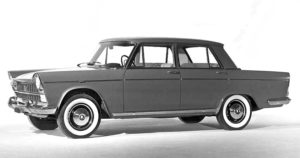
Fiat 2100
The aim of the first generation Debonair (hereafter Debonair) was to be a chauffeur driven car mainly for the Mitsubishi Group and its affiliated companies. The engine was a newly developed 2-liter, twin carburetor inline 6-cylinder with dual exhausts and 105 horsepower, one of the highest in its class. This was a different direction compared to the Toyota Crown and Nissan Cedric, which had the same engine displacement but were also available in taxi cab versions. At the time, there was already a chauffeur driven model that stretched the body of the Cedric, but the Debonair was Japan’s first exclusive chauffeur driven car.
The design of the Mitsubishi 500, which was launched at that time, was not well received by the market. To be fair, Mitsubishi’s expertise in car design itself was not up to the world’s standards. This led to a discussion among the executives on how to leverage the design capabilities. As a result, they decided to invite Hans Bretzner, a designer at General Motors, who wanted to take a leave of absence from the company to become a design consultant for a Japanese car maker, to design the Debonair, and at the same time, to learn his design know-how. This was arranged by Tsubota, deputy general manager of the engineering department, who had studied at the California Institute of Technology.
(Hans Bretzner’s life before comming to Japan)
―― Contribution of Hans Brezner
From here, I would like to share the memories of Shinichi Mitsuhashi, who had just joined the company at that time and watched Bretzner’s work from the side.
Hans, who came to Japan in 1961, was a German-American and was 30 years old at the time. Together with Tsubota and Awata of the administration dept., we made elaborate preparations for his arrival, including arranging for a luxury apartment and preparing a refrigerator, which was not yet common at the time. Hans was in charge of the exterior and interior design of Debonair, but Kensaku Kobayashi, who had been with the company for two years, was in charge of the design project, and he devoted himself to backing Hans up from start to finish.
The first thing that surprised me about Hans’ work was the full-size rendering. A roll of Kent paper was stretched out on the wall, fastened with a stapler, and drawn on with chalk (pastel). After applying the chalk, he rubbed it with his fingers to express the gradation. I tried to imitate him, but I remember that I lost my fingerprints and my fingertips went numb. His sketching and rendering techniques were truly those of a GM designer, and his artistic expression was superb. He taught us about highlight rendering and techniques using vellum paper through demonstrations.
Full-size rendering by Hans Bretzner
Not only the design but also the modeling work was all done under his direction. Hans also had experience as a modeler, so he was familiar with clay modeling and FRP modeling, and he taught us the techniques used at GM firsthand. At this time, Hans helped us to import Shavant clay. Although it was several times more expensive than the domestic product we used until then, the accuracy and ease of making the models were greatly improved. In addition, based on Hans’ instructions, Yoshimasa Mitsuya, the leader of the modelers, ordered the newly designed surface plate, clay oven, and extruder from an outside supplier with the cooperation of the production engineering dept. and the jigs and tools dept. As the modeling work reached its climax, they were short of manpower and received support from the prototype section. Furthermore, under Hans’ guidance, new works such as DI-NOC sheets and FRP were added, and with support from other departments, the work was done on an unprecedented scale. Later, some of the people who came to support us and acquired new skills were reassigned to the design section, and the design section grew rapidly.
In this way, GM’s design development techniques were instantly introduced. Earnest, meticulous, and craftsman-like, Hans was the perfect role model for us.
Hans’ biggest difficulty in designing the Debonair was the width of the car, which was 1,700 mm, the size of a Japanese small car regulation. The characteristic side design lines that kick up at the rear doors did not fit together as well as they should have because of this restriction. He had a hard time dealing with the surface treatment. We were told over and over again, “This is the worst law under the sun.” As an American designer, it was not unreasonable. However, thanks to his hard work, the Debonair became a car of such an imposing size that it was hard to believe it fit into the small car regulations.
Clay modeling (left) Early design with stacked headlights (right)
Hans dearly loved his Mercedes-Benz. I remember that he always took off the three-pointed star on the hood and put it in his pocket for afraid it would be stolen. On his days off, he would take his camera with him and frequently took pictures of Japanese customs such as festivals. I thought it was just one of his hobbies, but he told me that he would be paid a lot of money if he provided the photos to the appropriate organizations in the US. I was very impressed with his shrewdness.
When the design of the Debonair was almost finished and the prototype was completed, he temporarily returned to the U.S. and visited the GM studio for the first time in a while. There, he saw that the trend of the latest model had changed greatly, and upon his return, he offered to change the design. The front of the car was changed from a stacked quad headlight design to an ordinary quad headlight design, which was the final result. In hindsight, this design had a lot of similarities to Ford’s luxurious car, the Lincoln Continental. I was strangely convinced when I heard that it was designed by Elwood Engel, the future boss of Chrysler Design, who was a close friend of Hans.
Highlight rendering sketch by Hans Bretzner
Debonair with a plate envisioning the Tokyo Olympics in 1964
But even so, his efforts made the Debonair look great, and most importantly, we had access to the latest design techniques. I am grateful that Mitsubishi Design has been able to grow since then because of him. Hans presented two ideas for the name of the car, Debonair and Marquis, and finally, the president decided on Debonair. Hans had a hand in everything that went into Debonair, including a brochure with his hand-drawn sketches and the display at the Tokyo Motor Show.FRP model of final design. Bretzner preferred door mirrors
Hans was a personable and caring man. One day, Hideo Kodama, a student at Tama Art University, came to see Hans for job hunting. Hans introduced him to GM, but at that time, GM had a difficult visa situation and he ended up going to Opel. So Kodama looked up to Hans as his benefactor. In 1965, Hans left Japan for his new home in India. However, there was no challenging work at Hindustan Motors and he returned to the United States. After that, he married his young wife Anita, who was considerably younger than him, and they visited Japan, where he was happy to get reunited with us at his old workplace. Later, I learned from Kunihisa Ito, a designer living in the U.S., that Hans passed away in 2007. Ito and Kodama, who was just at the Detroit show, went to see Anita (who works at the Japanese Consulate). After that, Kodama visited Hans’ grave and went back to Germany.
―― ”Running Coelacanth”
The “Running Coelacanth” was the nickname given to the Debonair. Unfortunately, I have to say that this is a well-fitting phrase. The Debonair was launched in 1964 and survived for 22 years before its successor, the Debonair V, came out. The Debonair was a scaled-down version of the American luxury car, and even so, the L-shaped rear combination lights and the front design were highly original and perfect. In the 1960s, American car design was at the height of its prosperity, and its influence extended to European cars, including Mercedes-Benz, the Toyota Crown and the Nissan Cedric were no exception. The Debonair was one of those unique cars that had a strong American flavor but was not an American car in terms of size and character. However, the influence of the American style on the world gradually subsided, and the design of the Debonair did not influence the design of Mitsubishi cars in the future.
―― Outcome of Debonair development
The lifetime sales volume of the Debonair in 22 years was about 22,000 units, which was not profitable at all. As was suspected at the initial planning stage, this was a high-end luxury car in Japan, and considering the sales capacity at the time, it would have been difficult to sell enough units to make a profit, so this project was probably unreasonable from the outset. Nevertheless, the enthusiasm for creating a flagship car for Mitsubishi must have been quite strong among the management. The Debonair served as a symbol of Mitsubishi Motors, even if it was unprofitable. Moreover, the development of the Debonair was an opportunity for the Mitsubishi design to grow and develop in the years to come. All of this was possible thanks to a little guidance from MITI prior to the development of the Debonair, which led to the work with the best partner, Hans Bretzner.
March 2022
First luxury car interior design
Haruo Okamoto
―― Beginning of work
Around 1962, about a year and a half after I joined the company, I was working on the Colt 1000 but was suddenly asked to change to the interior design of the 1st gen. Debonair (hereafter Debonair). I worked under Hans Bretzner and Kensaku Kobayashi. Since Hans was to be solely responsible for the design, my job was to build a model based on his design, finalize the design with the engineering department, and communicate with vendors. The work was extremely hectic, but it was a series of new experiences and very rewarding. Hans was able to speak Japanese to some extent, although I don’t know when he learned it, which was a big help to me since I could not speak English at all, and I was able to work comfortably. While the exterior model of Debonair was being worked on in the large, new design studio on the first floor of the research building, the interior work was done in the old design room on the fourth floor of the main technical building, which could be called Hans’ design room.
―― Clay modeling design
When I joined the work, some full-size renderings of the instrument panel and seats were already in place. Hans explained the design aims of the instrument panel. It was to have a full-width garnish between the upper and lower pads that would be continuous to the doors. The meter hoods were to be placed inside the garnish and not protrude above the pads, to keep the forward view clear. A chrome-plated seesaw switch was to be placed next to the meter hood in the shape of a rice paddy. Based on the explanations and the cross section of the image, I fabricated a clay model with the support of a modeler. The model was built on a stand with a temporary seat, to which the front doors, front deck, and front pillars could be added later when needed.
Following the instrument panel, the front seats were modeled while considering trimming and sewing lines. Various small parts such as switch knobs, inside door handles, armrests, and window regulator handles were then designed, mostly based on Bretzner’s sketch instructions, while communicating with the engineers.
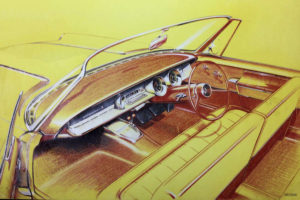
Early instrument panel design sketch
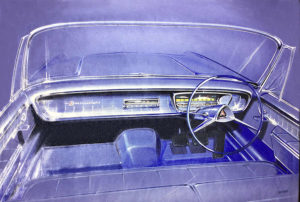
Sketch close to final design
In those days, there was not yet the idea of making a solid interior model to check the overall interior design. In addition, the schedule was tight because we started work on the interior after the exterior was completed, so we had to get the approval of each completed part one by one. Therefore, it was not until the 1963 Tokyo Motor Show that we were able to see the entire interior.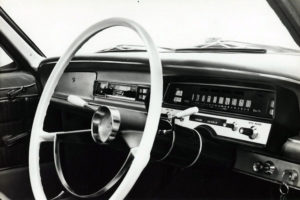
―― Motor show car painted in pearl white
The motor show reference exhibit, named “Colt Debonair,” was painted in pearl white. This color was also used for the production model, which at the time was probably the first pearl paint with mica in Japan. A few days after the painting of the car was completed, a blackened spot emerged from under the paint, causing a great deal of panic among the people involved. It was later discovered that this was caused by magic ink that had been written on the sheet metal. Naturally, the painting had to be redone. All the body colors for the Debonair were planned by Hans and created after much communication with the paint manufacturer.
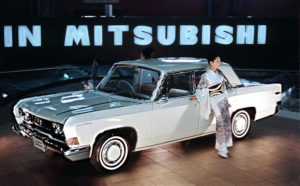
Colt Debonair on reference exhibit at the 1963 Tokyo Motor Show Source: Motor Fan Archive
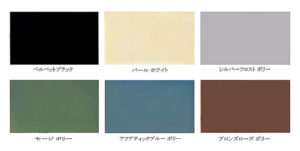
Body color samples on brochure
The seats were a luxurious combination of pearl leather and textured Jacquard fabric. Normally, the fabric was selected and tuned from the fabric manufacturer’s suggestions, but Hans went to a textile factory in Nishijin, Kyoto, and created the fabric with detailed pattern instructions from the beginning. The trimming was a cookie-type design, and the seat back was designed to be less tall to enhance the spaciousness. The instrument panel padding was made from electroformed molding to create a fine grained texture. The door trims are fitted with slender garnishes that are in continuity with the instrument panel garnish, and together with the horizontal instrument panel, created an interior design with a sense of openness. In addition, the Debonair was available in only one grade, and it had the finely detailed features of a luxury car, such as door armrests with built-in lamps for foot lighting, a radio control panel for the rear seats, openable rear triangular windows, and trunk compartment lighting.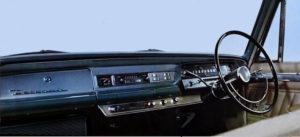
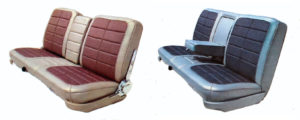
―― Summary
Back then, everyone, including the engineering department and vendors involved, had little experience in car design development. I think we all had a strong desire to complete the project for the future, based on the thoughts and instructions of Hans, who had acquired the know-how of General Motors, which was far ahead of us in car design. Working on the Debonair interior was a great period of fertilizer for me for the rest of my career. I was able to learn and experience a wide variety of things by being involved in every step of the process, from making clay models studying their shapes to putting all the interior parts into production. These experiences led me to work on interiors for most of my design career.
October 2021
